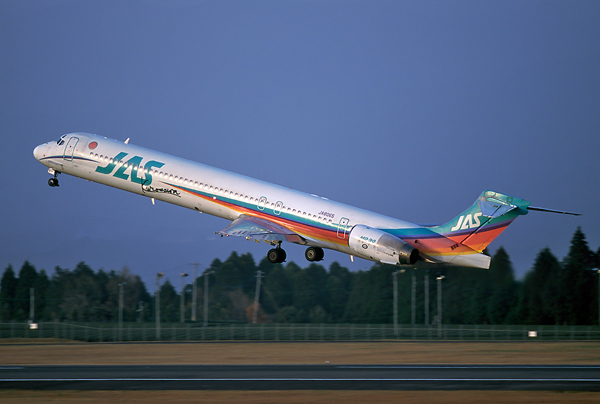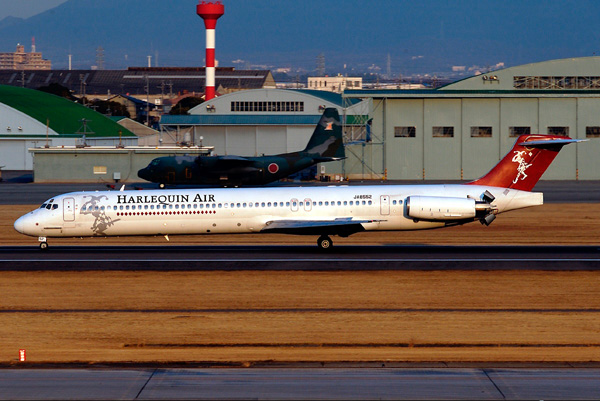More symbolism
Alas, the second halve of the nineties brought an end to euforia. The company had to give up on Singapore and Honolulu due to competition and the B747 plan was no more realistic. For a short while Japan Airlines' JA8171 (23391) was tested but that was to be all. Renewal of the fleet carried on at a steady pace though. All YS-11s had been transferred to JAC and the last of the DC-9s were following their brethren to Airborne Express to be converted into freighters. During '98 and '99 the oldest of the MD-81s left for the States as well and were replaced by sixteen MD-90s. Additionally, the Boeing 777 acquired a place in the JAS stables by the end of 1996.
At the Ministerial Council on Economic Affairs in September 1995 the decision was made to introduce a so-called 'airfare band system' to stimulate competition on the domestic market and necessitate cost reductions. Starting May the following year airlines were free to vary ticket prices provided they did not exceed what was justified for by the 'standard costs' on a certain route. These costs were determined by looking at the actual costs on several routes already served under competition and with that provided quite a challenge.
In order to keep the spirits up Nihon Air System decided to give her new aircraft an even better look than they would have in Airbus Rainbow colours. Help was found in the person of Akira Kurosawa, one of the most influencial movie directors of the 20st century - all the famous of the past few decennia name him as their example. Kurosawa designed no less than seven different rainbow themes on a white background for the MD-90 fleet so each scheme could be displayed on a maximum of three, and mostly even just two, aircraft. The seven designs can be described as follows:
1. 'JAS' stylized large in blue, behind that rainbow colours on centre
fuselage. JA8004, JA8064 and JA005D.
2. Rainbow from very thin near front
to wide on tail, signature of Kurosawa. JA8020, JA8065 and JA006D.
3.
Rainbow from wide at lower front to thin near tail. JA8029 and JA8063.
4.
Blue-green nose and tail fin, rainbow like version 3. JA8062 and JA001D.
5.
Rainbow from thin at lower front to wide at rear, blue-green tail. JA8066
and JA002D.
6. Wide-stretched rainbow on rear fuselage halve and piece
of tail. JA8069 and JA003D.
7. Thin-waisted rainbow from lower front to
lower back. JA8070 and JA004D.
The bilangual titles had to go, the only conspicuous lettering on these MDs is in the JAS logo. Kurosawa-san died on September 6, 1998 but luckily lived long enough to see all of his beautiful designs take to the air.

The public in Japan, and aviation enthousiasts world-wide alike, are sad to see the disappearance of this flying art and the strong positive symbol of the rainbow. A similar story goes for the Triple Seven. Very appropriately seven of these parade-horses were acquired and these too had to receive a new and joyfull colour scheme that just had to be designated 'Rainbow Seven'. By tradition, JAS did not start off with paper and pencils itself, but instead this time a design contest was lauched. The winning design was to soar the skies on seven wide-bodies for years to come, and then thirteen-year-old Masatomo Watanabe received this honour. This junior school-boy lived close to Sapporo-Chitose and was an aircraft spotter to be, as he could already recognise aircraft types by the sounds of their engines. After reading about the contest in the paper it took him only a few hours to conceive his asymmetric design, consisting basically of a rainbow-coloured ribbon twisted around the plane from nose to tail. 'Japan Air System' is written diagonally on the vertical stabilizer, the JAS logo is applied to the forward fuselage and a red sun on the right 'cheek' of the 777 makes for the finish. This is the idea that most impressed master Kurosawa and the rest of the jury. Additionally, there were many special awards and categories, among which the Special Award for Overseas Submissions, won by Dutch national Max Kisman who filled the airplane's surface with very big lettering 'Japan Air System' in rainbow colours. The JAS website used to display a whole gallerie of designs, before it was reduced to merely a link to the new JAL group.
[1] Noted in new JAL Group colours.
MD-90 |
|||
| 53352 | JA8062 | 30jun95 | Initially stored Kingman, AZ, and Long Beach, CA. In service after May 1996. |
| 53353 | JA8063 | 23oct95 | |
| 53354 | JA8064 | 19dec95 | |
| 53355 | JA8065 | 18mar96 | |
| 53356 | JA8066 | 31oct96 | |
| 53357 | JA8069 | 24dec96 | |
| 53358 | JA8070 | 01may97 | |
| 53359 | JA8004 | 02jun97 | |
| 53360 | JA8020 | 29jul97 | |
| 53361 | JA8029 | 31oct97 | Initially stored at Tokyo-Haneda, in service 2nd halve 1998. |
| 53555 | JA001D | 18nov97 | |
| 53556 | JA002D | 18dec97 | [1] feb04 |
| 53557 | JA003D | 24dec97 | |
| 53558 | JA004D | 29dec97 | |
| 53559 | JA005D | 29jul98 | [1] 19mar03 |
| 53560 | JA006D | 27oct98 | |
First one is MD-90, rest are MD-90-30.
B777-289 |
|||
| 27636 | JA8977 | 03dec96 | |
| 27637 | JA8978 | 27jun97 | |
| 27638 | JA8979 | 26nov97 | |
| 27639 | JA007D | 27apr98 | |
| 27640 | JA008D | 23jun98 | |
| 27641 | JA009D | 02sep98 | |
| 27642 | JA010D | 13may99 | |

So these are the modern
times: MD-87 JA8370
in the New JAL Group colour scheme featuring the Arc of the Sun, in symbolic
red, silver and black on an off-white base. Looking good, but regrettably
to the expense of a lot of other colours.
(Misawa, 14 November 2003)
During this period the rotary-wing aircraft had been phased out. The only light planes still operated by JAS were a Beech 58 (JA5311, TH-1656 , faith unknown) and three Beech B200s, the JA8879 (BB-1401), JA8880 (BB-1406) and JA8784 (BB-1463), all for training purposes. The first two King Airs flew with JAS for seven years starting mid 1991 and the last one only stayed for about a year from 1993 on. All were returned to a leasing company eventually.
The last child of Nihon Air System was born on January 20, 1997: Harlequin Air , and again the name was not translated in Japan. This company, with its base in Fukuoka, specializes in ad hoc charter flights abroad and has a 100% JAS ownership, meaning it belongs to the JAL group now. Alas, demands are very scarce these days and of two aircraft ever having carried the Harlequin livery only MD-81 JA8552 (53297) remains, now being operated on JAS routes. The other one was DC-10-30 JA8550 (48315) that received additional JAS logos and titles at some point. Meanwhile this tri-jet has visited the Netherlands on countless occasions as Northwest Airlines' N243NW.
To westerners the harlequin may not appeal that much as a symbol for an airline company but in the land of the rising sun deeper meanings are understood. The company itself put it this way: 'Harlequin is originally the character that appeared in Italian classical comedies. He is a cheerful and funny character with suppleness, charm, and intelligence and he is loved by many fans. (...) The harlequin is very skillful in performance, and satisfies the audience by playing many roles as a stage actor.' Harlequin Air tried to motivate people to actually visit fascinating destinations rather than just dream about them.

On a winter evening one of two aircraft ever to wear Harlequin Air colours arrives at Nagoya-Komaki. JA8552 still looked like this by the end of March 2004, albeit with added new JAL logos. (December 2001, Hideaki Ohki)